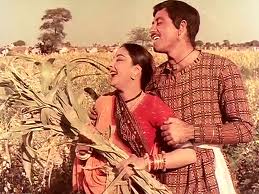Critical Review of the Hindi Film Mother India
Mehboob Kahn’s 1957 film Mother India is a Hindi classic, a tragic drama of a rural family struggling to survive post-independence India. Radha marries Shamu and inherits the inescapable land debt that Shamu’s mother owes the avaricious loaner Sukhi. The family’s attempt to pay off the debt only leads to spiraling indigence and suffering, from Shamu’s dismemberment and flight to the death of two of Radha’s children, one by her own hands.
 |
| Radha Struggling To Feed Her Kids |
Mother India is as political as it is historical and cultural. It overtly registers the land disputes that foreshadowed India’s independence. While the conflict between Sukhi and Shamu’s mother outlines the pervasiveness of patriarchal power, all the council elders are men, it perhaps more vividly shows the vulnerability of illiterate rural dwellers to the vagaries of the capitalist ethos propagated by independent India. Sukhi is not simply the village schemer. To the villagers, with his hidden ledger and indecipherable accounting system, he represents external business interests and governmental systems. As a critique of nationhood, the film clearly shows the peasants’ distrust of governmental structures and the inability or unwillingness of the State to provide them with effective buffers and protection, not that it would have been easy, for as one villager elder noted, “The police should never enter our village.”
 |
| Working to Pay the Family's Lifetime Debt |
Mehboob goes the distance in recreating rural India, melodramatizing traditional values and practices. He could not have chosen a more powerful ritual than the wedding and the institution of marriage to introduce his audience to the values, norms, and morays that set the foundation for the unfolding tragedy. By situating much of the film’s action against agrarian backgrounds, he establishes the intimate connection between the land and the villagers.
 |
| Evoking Happiness in Perpetual Poverty |
The plot unfolds as a flashback in the life of an elderly village woman called Radha. The flashback operates as reclamation of the painful history of partition. Even at the end of the movie, while the village celebrates the inauguration of a water dam, the forlorn Radha, who seems emotionally suspended in the past, is reluctant to participate; instead of celebrating the irrigation benefits that the dam promises, perpetually mourning her painful encounters with the transitions of partition, she reflects not on the future of water but the past of bloodshed.
 |
| Radha in Deep Contemplation |
While the film presents rural India in its most pastoral form, it constructs complex gender relationships that blur the feminine and masculine power divide. The women characters, though contained within patriarchal dominance are inherently empowering. Radha’s fortitude and gumption belie the typical depiction of women as a romantic prize or a sexual gaze in traditional Hindi film. She traverses and redefines gender roles, conflating concepts of masculinity and femininity into a singular reflexive will to survive and care for her children. So physical strength, courage, defiance, and virtue, values traditionally invested in male characters all belong to her. Alternatively, the film perpetuates traditional Hindi films’ portrayal of fatherhood, typically fraught with absent men, men unable to effectively meet their filial responsibilities, or men whose agency is temporal, inevitably disappearing, in their tracks whiffs of emotional distress or a painful memories.
 |
| Shamu Loses his Arms Trying to Move this Rock |
The main protagonist, Radha is not simply a victim of partition; she is partition itself, representing the pain and suffering caused by the historic separation of peoples, cultures, and families. She carries the pain of the period as much as she negotiates her survival around it. Director Mehboob most effectively illustrates this when he twice presents prolonged scenes of Radha painfully dragging a cross-shaped plow, exploiting the biblical imagery of Simon of Cyrene carrying the cross of Jesus in the Christian story of crucifixion.
 |
| Radha in a Simon of Cyrene Strut |
The film also deviates from common Hindi films in its metaphoric situation of conflict. While the film centers nationalistic struggles within the family domain, it does not use the family to represent the nation. In Mother India, the village becomes the nation. So while Radha negotiates nationhood through her filial duties, loyalties, and obligations, the film subsumes this struggle within larger communal rules, values, and traditions. Thus, her untrammeled need to comfort and protect her son, Birju, a validation of the Freudian theory of oedipal complex, cannot supersede her commitment to the nation, for the audience can reasonable approach the village as a metaphor for the nation.
 |
| Radha's oedipal connection to her sons |
Therefore, when Birju is about to commit sacrilege against the village, the despoiling of its bridal prize, she shoots him in the back, an aggressive act in honor of the nation that no context can demoralize. Also, Radha’s military pose and the symbolism of the gun as the punitive instrument should not be understated, since the gun serves as an apt symbol of governmental authority and her reaction a patriotic act of national defense.
 |
| A Mother's Deepest Anguish |






























